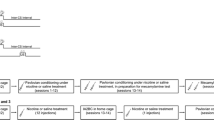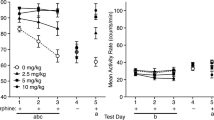Abstract
The role of Pavlovian conditioning in the development of tolerance to the hypothermic effect of ethanol and of cross-tolerance to hydralazine was investigated. In the first study, two groups of rats were treated on alternate days with ethanol (2 or 4 g/kg, respectively, IP) in a novel and distinctive environment (DR). On the non-alcohol days, they received saline in the home room (HR). A control group received saline in both environments. Tolerance to the hypothermic effect of ethanol in the DR was demonstrable in both the 2 and 4 g/kg treatment groups. Tolerance in the HR, however, was observed only in the 4 g/kg treated group. Cross-tolerance to the hypothermic effect of hydralazine was observed for both ethanol-treated groups in the DR but not in the HR. In the second study, ethanol treatment was carried out by daily intubation with 6 g/kg ethanol in the home cage. Tolerance to ethanol-induced hypothermia was demonstrated either in the home cage or in a novel environment. This treatment, however, failed to confer cross-tolerance to the hypothermic effect of hydralazine. These findings suggest that conditioning plays a predominant role in the tolerance produced by low but not by high treatment dosage. The data also suggest that conditioning might be a separate component in tolerance development, which is of special importance in tolerance to behavioral effects in the whole animal rather than to cellular or molecular effects.
Similar content being viewed by others
References
Baker TB, Tiffany ST (1985) Morphine tolerance as habituation. Psychol Rev 92:78–108
Barry H (1983) Adaptive behavior of alcohol tolerance and with-drawal. In: Cicero TJ (ed) Ethanol tolerance and dependence: Endocrinological aspects. Research Monograph No 13, National Institute on Alcohol Abuse and Alcoholism. DHHS Publication No (ADM) 83–125, Washington, pp 16–26
Crowell CR, Hinson RE, Siegel S (1981) The role of conditional drug responses in tolerance to the hypothermic effects of ethanol. Psychopharmacology 73:51–54
Erickson CK, Koche KI, Mehta CS, McGinity JW (1978) Chronic dependence with a sustained alcohol release implant in mice. Life Sci 22:1745–1754
Ferko AP, Bobyock E (1979) Rates of ethanol disappearance from blood and hypothermia following acute and prolonged ethanol inhalation. Toxicol Appl Pharmacol 50:417–427
Goldstein DB (1974) Rates of onset and decay of alcohol physical dependence in mice. J Pharmacol Exp Ther 190:377–383
Greeley J, Lê AD, Poulos CX, Cappell H (1984) Alcohol is an effective cue in the conditional control of tolerance to alcohol. Psychopharmacology 83:159–162
Kalant H, Khanna JM (1980) Environmental-neurochemical interactions in ethanol tolerance. In: Sandler M (ed) Psychopharmacology of alcohol, Raven, New York, pp 107–120
Kalant H, Lê AD (1984) Effects of ethanol on thermoregulation. Pharmacol Ther 23:313–364
Kalant H, LeBlanc AE, Gibbins RJ (1971) Tolerance to, and dependence on, some non-opiate psychotropic drugs. Pharmacol Rev 23:135–191
Khanna JM, Lê AD, Kalant H, LeBlanc AE (1979) Cross-tolerance between ethanol and morphine with respect to their hypothermic effects. Eur J Pharmacol 59:145–149
Khanna JM, Kalant H, Lê AD, LeBlanc AE (1980) Reversal of ethanol tolerance and cross-tolerance to pentobarbital in the rat. In: Thurman RG (ed) Alcohol and aldehyde metabolizing systems, Vol III. Plenum, New York, pp 779–786
Lê AD, Poulos CX, Cappell H (1979) Conditioned tolerance to the hypothermic effect of ethyl alcohol. Science 206:1109–1110
Lê AD, Kalant H, Khanna JM (1982) Interaction between des-Glycinamide9-[Arg8]vasopressin and serotonin on ethanol tolerance. Eur J Pharmacol 80:337–345
Lê AD, Kalant H, Khanna JM (1986) Influence of ambient temperature on the development and maintenance of tolerance to ethanol-induced hypothermia. Pharmacol Biochem Behav 25:667–672
Lomax P, Bajorek JG, Bajorek T-A, Chaffee RRJ (1981) Thermoregulatory mechanisms and ethanol hypothermia. Eur J Pharmacol 71:483–487
Mansfield JG, Cunningham CL (1980) Conditioning and extinction of tolerance to the hypothermic effect of ethanol in rats. J Comp Physiol Psychol 94:962–969
Melchior CL, Tabakoff B (1981) Modification of environmentally-cued tolerance to ethanol in mice. J Pharmacol Exp Ther 213:175–180
Melchior CL, Tabakoff B (1984) A conditioning model of alcohol tolerance. In: Galanter M (ed) Recent developments in alcoholism, vol 2. Plenum, New York, pp 5–16
Melchior CL, Tabakoff B (1985) Features of environment-dependent tolerance to ethanol. Psychopharmacology 87:94–100
Rigter H, Crabbe JC Jr, Schönbaum E (1980) Hypothermic effect of hydralazine in rodents. Naunyn-Schmiedeberg's Arch Pharmacol 342:209–217
Ritzmann RF, Tabakoff B (1976a) Body temperature in mice: a quantitative measure of alcohol tolerance and physical dependence. J Pharmacol Exp Ther 199:158–170
Ritzmann RF, Tabakoff B (1976b) Ethanol, serotonin metabolism, and body temperature. Ann NY Acad Sci 273:247–255
Siegel S (1975) Evidence from rats that morphine tolerance is a learned response. J Comp Physiol Psychol 89:498–526
Siegel S (1976) Morphine analgesic tolerance: its situation specificity supports a Pavlovian conditioning model. Science 193:323–325
Siegel S (1983) Classical conditioning, drug tolerance, and drug dependence. In: Smart RJ, Glaser FB, Israel Y, Kalant H, Popham RE, Schmidt W (eds) Research advances in alcohol and drug problems, vol 7. Plenum, New York, pp 207–246
Tabakoff B, Ritzmann RF (1977) The effects of 6-hydroxydopamine on tolerance to and dependence on ethanol. J Pharmacol Exp Ther 203:319–331
Author information
Authors and Affiliations
Rights and permissions
About this article
Cite this article
Lê, A.D., Khanna, J.M. & Kalant, H. Role of Pavlovian conditioning in the development of tolerance and cross-tolerance to the hypothermic effect of ethanol and hydralazine. Psychopharmacology 92, 210–214 (1987). https://doi.org/10.1007/BF00177917
Received:
Revised:
Issue Date:
DOI: https://doi.org/10.1007/BF00177917




